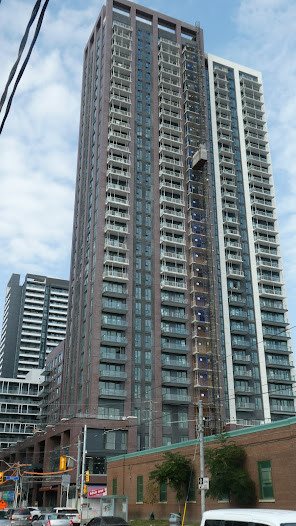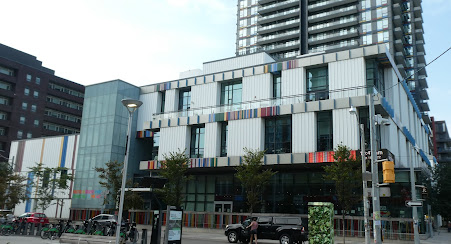I spent the past weekend attending a Family Reunion in Toronto. As I wandered around the city, I saw many things that I’d like to see in Vancouver and many things that I'd prefer not to see. Here are a few observations.
New
buildings are very big. When I studied architecture in the late 60s and early 70s, I recall a
lecture by visiting professor Jack Diamond who thought 3 FSR was the maximum
for a livable residential environment. This
is about 5 times the density of a conventional single-family neighbourhood;
three times the density of a typical townhouse development; twice the density of
Kerrisdale highrises and much of the West End; and slightly more than most of the new
6-storey buildings along the Cambie Corridor
However, it
is about half of the proposed density (6.5 FSR) for many highrise development sites along the Broadway Corridor and much less than most new
highrise developments in Toronto which are often around 10 or 11 FSR. This prompts me to wonder, when
is big too big? I guess it all depends on what you are used to and whether you believe that more density equates to greater housing affordability.
Colourful buildings. Some new developments that I happened to see incorporate more colour than what we generally see in Vancouver. While I am not sure how these buildings will ‘date’ over time, I like them. Here are just a couple of examples I came across walking along Dundas Street.
Colourful
murals often appear on buildings and along lanes.
Stacked
townhouses. This is
a common form of housing found throughout Toronto but still very limited in Vancouver…at
least so far. Stacked townhouse buildings can be identified by multiple front doors at the entry.
Two doors serve the lower-level suites; two doors provide entry to the main level suites; and two lead
up to upper-level suites. While these developments have a lot of stairs, for many households this is an attractive affordable alternative to a four to six storey apartment building at a similar
density.
More and
better bicycle lanes. Thanks initially to Gordon Price and Peter Ladner, Vancouver has a growing
network of bicycle lanes around the city. But I was surprised to see so many attractive, separated bike lanes throughout downtown Toronto. (I had a similar surprise when
visiting Montreal a few years ago.)
Traffic congestion and inadequate parking. Since there were seven of us (including two young children) we rented a AirBnB in the downtown. It was a new, four level semi-detached townhouse near Broadview and Dundas.
While we initially thought we could manage without a car, relying on taxis, uber and public transit, we soon realized we needed a car. This led to two discoveries.
Toronto's roads seemed so much more congested than Vancouver’, Moreover, while
I applaud Toronto's significant reduction or elimination of minimum parking requirements, it's difficult to find parking in many downtown neighbourhoods. I often had to drive around for about 20 minutes before finding a parking space anywhere near our
house. As Vancouver reduces or eliminates parking requirements, I can't help but wonder whether this is the future of many Vancouver neighbourhoods where single-family houses may be replaced by 'gentle density' and six-storey apartment buildings.
Here are a
few more things that I noticed.
A truly multi-cultural city. While Vancouver is very multi-cultural when compared to most other Canadian cities, judging by Toronto's commercial areas, it is much more cosmopolitan.

The Toronto ‘Semi’. Recently, I’ve spent a lot of time reviewing apartment plans for new developments in West Vancouver. So, it was particularly interesting to stay in a new Toronto semi-detached 'townhouse' and compare it with typical Vancouver duplex. Our unit had four storeys and was recently on the market for just under $2 million. The main difference between a Toronto semi and a Vancouver duplex is that a semi comprises two separate units on two separate lots, with a common party wall. A duplex, on the other hand, comprises two units on one lot. As a result, it is a strata development.


Signs, signs At the corner of Dundas and Yonge is a lively public space with illuminated signs reminiscent of Times Square and many Asian cities. There's nothing like it in Vancouver. While some will say 'thank god', I would like to see more active, visually lively spaces like this.
Reduced speed limits. In many parts of the city, the maximum limit is 40 km/hr and PEOPLE KEEP TO THE SPEED LIMIT. This might be due, in part, to numerous speed notification signs throughout the city. We should do that here!














No comments:
Post a Comment